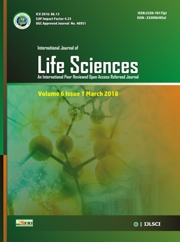RESEARCH ARTICLES
Volume 8 |Issue 1| January-February 2020 First published: 30 February 2020
Monthly variations of Cladocerons in fresh water body upper Wardha Dam, District- Amravati(M.S.)- India.
Awate PJ
Department of Zoology, Late R.Bharti Arts, Commerce and Smt.S.R.Bharti Science College, Arni Dist-Yavatmal. 445103 (MS) India.
Abstract
Keywords: Zooplankton, Cladocera, Mesotrophic, Upper Wardha Dam,fresh water body.
Editor: Dr.Arvind Chavhan
Cite this article as:
Awate PJ. Monthly variations of Cladocerons in fresh water body upper Wardha Dam, District- Amravati(M.S.)- India., Int. Res. Journal of Science & Engineering, 2020. Volume 8 (1) : 35-39.
References
1. Chakraborty, RM, Kimmel DN, Stivers LJ, Davison and R. Deka,: Relative mutation rates at di-, tri- and tetra-nucleotide microsatellite loci. Proc. Natl. Acad. Sci. USA., 1997,94: 1041-1046.
2. Berlgis and Guido. Cyst-Based Toxicity Tests XV- Application of Ostracod Solid-Phase Microbiotest for Toxicity Monitoring of Contaminated Soils. Environ Toxicol., 2003, 18: 347-352.
3. Contreras-Jiménez J., S.S.S. Sarma, M. MerinoIbarra and S. Nandini(2009): Seasonal changes in the rotifer (Rotifera) diversity from a tropical high altitude reservoir (Valle de Bravo, Mexico). J. Environ. Biol., 30, 191-195.
4. Islam, S. N. (2007): Physicochemical condition and occurrence of some zooplankton in a pond of Rajshahi University. Res. J. Fish. and Hydrobiol. 2(2): 21-25.
5. Madin LP, Bollens SM, Horgan E, Butler M and others (2001) : Voracious planktonic hydroids: unexpected predatory impact on a coastal marine ecosystem. Deep-Sea Res II 43:1823–1829.
6. Hessen, D.O., Faafeng, B.A. & Brettum, P. (2003) : Autroph: Herbivore biomass ratios, carbon deficits judged from plankton data.- Hydrobiologia, 491: 167175.
7. Forro, L.,Korovchinsky,N.M.,Kotov, A.A.& Petrusek,A.(2008).: Global divercity of cladocerans (Cladocera; Crustacea) in freshwater.- Hydrobiologia, 595:177-184.
8. APHA(1989) : Standard Methods for the Examination of Water and Wastewater, Washington,DC.
9. Edmondson WT, (1959).: Ward and Whipple’s Freshwater Biology. 2nd ed., John Wiley & Sons Inc., New York, 1248 pp.
10. Goldman CR and AJ Horne III (1989) : Limnology. Int. std. Ed.MHI BookI Co. Londan.
11. Nasar, SA K. and Dutta Munshi J, Variation in seasonal physico-chemical and biological properties of a tropical shallow pond. Jap. J. Ecol.1974, 24(4): 255-259.
12. Saunders, PA, Porter KG, Taylor BE, Population dynamics of Daphnia spp. and implcatons for trophic interactions in a small, monomictic lake. – Journal of Plankton Research,1999, 21: 1823-1845.
13. Roff, DA, Life history evolution. Sunderland, MA: Sinauer.2002.
14. Harshman, LG & Zera AJ, The costs of reproduction: The devil in the details. Trends in Ecology & Evolution, 2006, 22, 80–86.
15. Bell, RE, The role of subglacial water in ice-sheet mass balance. Nature Geoscience, 2008, 1(5), 297-304.

